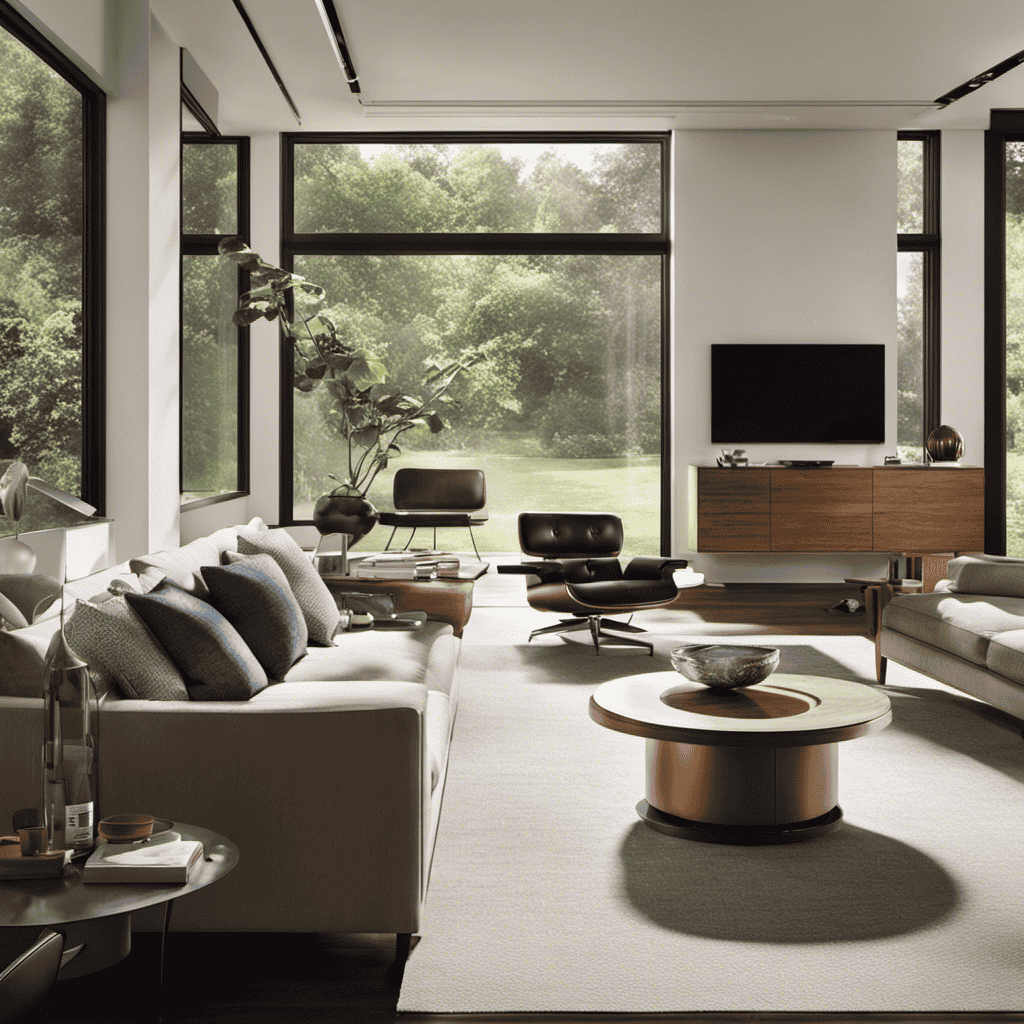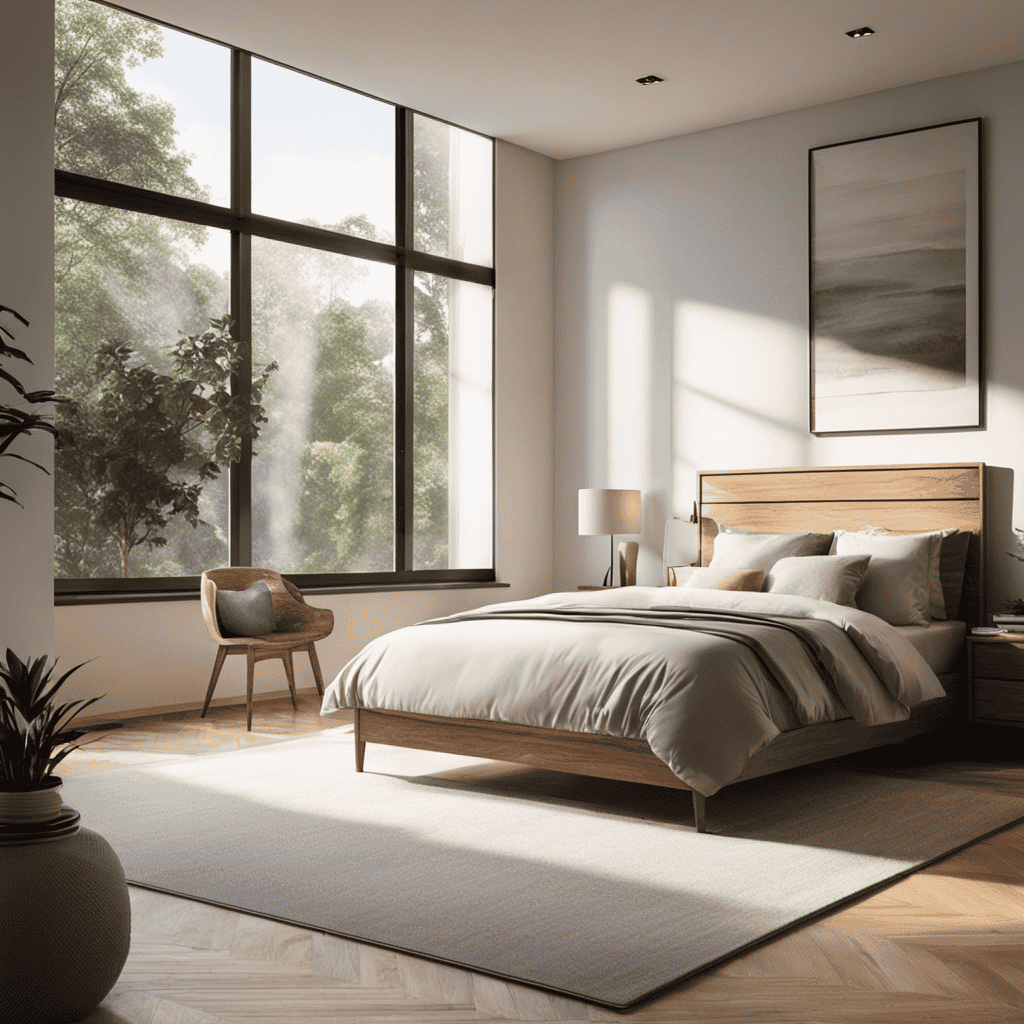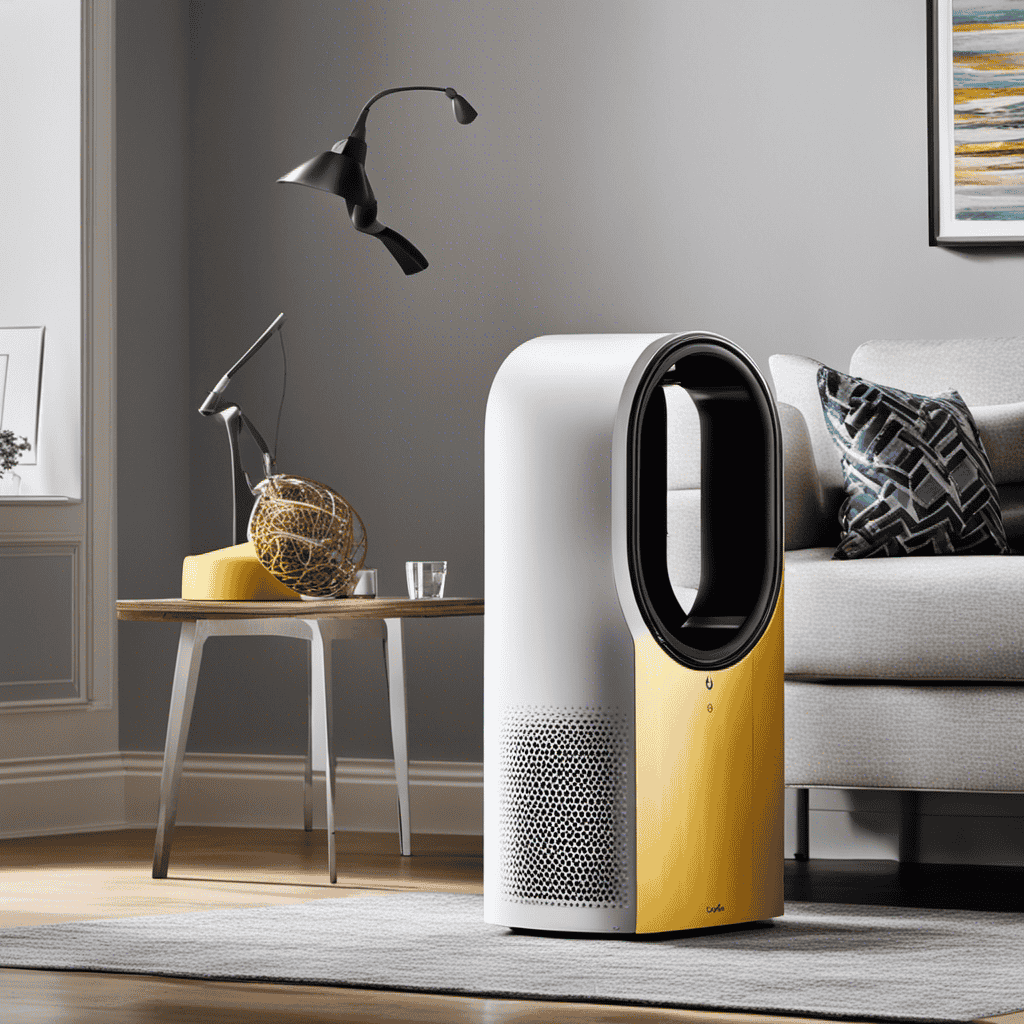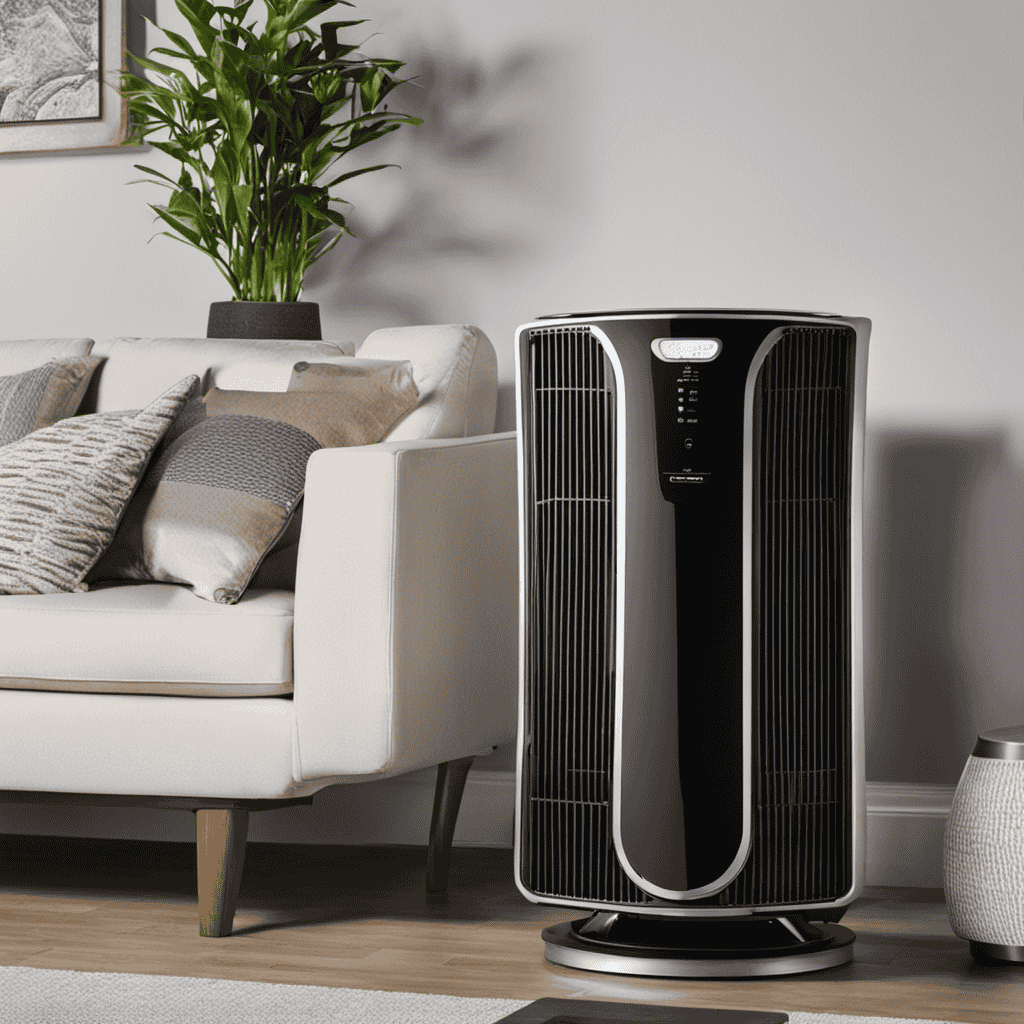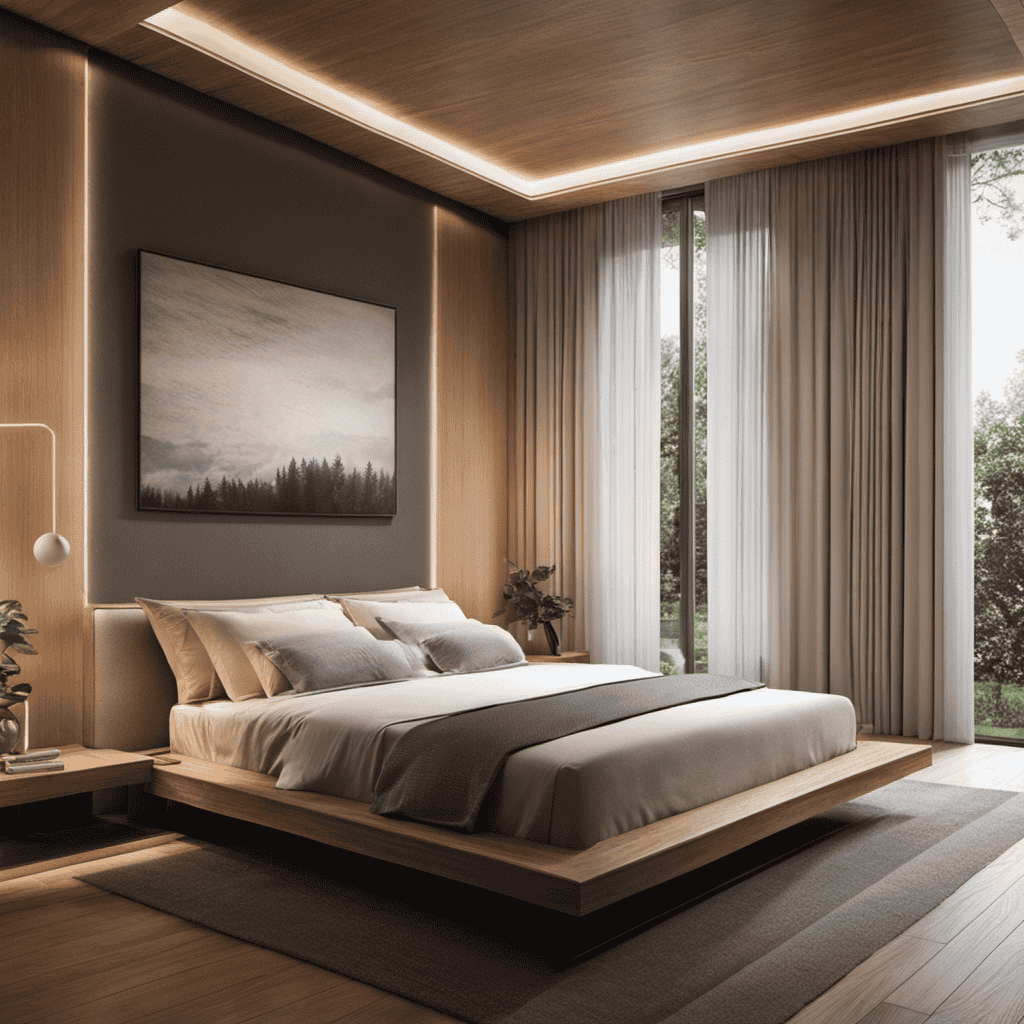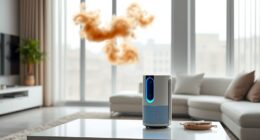I have to admit, positioning your Dyson air purifier correctly can significantly impact its effectiveness.
Let me guide you through the meticulous process of finding the perfect location.
In this informative article, we will explore the optimal placement for your Dyson air purifier in various areas of your home, from the bedroom to the polluted city.
Trust me, by following these scientific guidelines, you’ll be breathing in cleaner, fresher air in no time.
Key Takeaways
- Placing the Dyson air purifier in the bedroom ensures clean and pollutant-free air during sleep, promoting better sleep and overall well-being.
- Positioning the purifier centrally in the living room ensures proper purification and circulation of air throughout the entire room, creating a healthier environment for the family.
- Using a Dyson air purifier in the home office removes airborne pollutants and promotes comfortable and productive work by reducing allergens, irritants, and odors.
- Placing the Dyson air purifier near the crib or changing table in the nursery improves air quality for the baby, reducing respiratory illnesses and promoting better sleep quality.
In the Bedroom
You should place the Dyson air purifier in the bedroom to improve air quality while you sleep.
The benefits of bedroom placement for the Dyson air purifier are numerous. First and foremost, the bedroom is where we spend a significant amount of time, especially during the night when we sleep. By placing the air purifier in the bedroom, you can ensure that the air you breathe while you rest is clean and free from pollutants.
Additionally, the optimal placement for the air purifier in the bedroom is near or across from the bed. This ensures that the purified air is directed towards you as you sleep, maximizing its effectiveness.
In the Living Room
To effectively improve the air quality in your living room, it’s best to position the Dyson air purifier in a central location. This will ensure that the air is properly circulated and purified throughout the entire room.
Placing the air purifier in a corner or near a wall may limit its effectiveness, as it won’t be able to reach all areas of the room. By positioning it centrally, the air purifier can efficiently capture and remove pollutants such as dust, pollen, pet dander, and odors.
This will not only enhance the air quality but also provide several benefits. Firstly, it can reduce allergies and respiratory problems by removing airborne allergens. Secondly, it can eliminate unpleasant odors, leaving your living room smelling fresh and clean. Lastly, it can create a healthier environment for you and your family, promoting overall well-being.
In the Kitchen
When it comes to the optimal placement for a kitchen, there are a few key factors to consider.
Firstly, it is important to place the kitchen in a central location within the home, allowing for easy access and convenience.
Secondly, the kitchen should be positioned near the dining area, promoting seamless meal preparation and serving.
Lastly, a well-placed kitchen can enhance the overall flow and functionality of the home, making daily tasks more efficient and enjoyable.
These benefits of kitchen placement contribute to a well-designed living space that maximizes both practicality and comfort.
Optimal Placement for Kitchen
The best place to put the Dyson air purifier in the kitchen is near the stove and sink. This strategic placement ensures that the purifier can effectively filter out cooking odors, smoke, and other pollutants that are common in the kitchen.
Here are some tips for maintaining kitchen air quality:
-
Keep the kitchen clean: Regularly clean countertops, stovetops, and other surfaces to minimize the buildup of dust and food particles.
-
Proper ventilation: Make sure your kitchen has good ventilation by using exhaust fans or opening windows while cooking to remove smoke and steam.
-
Avoid chemical cleaners: Opt for natural cleaning products to minimize the release of harmful chemicals into the air.
Benefits of Kitchen Placement
Placing the Dyson air purifier near the stove and sink in the kitchen offers several benefits.
The kitchen is one of the areas in the house where proper ventilation is crucial. Cooking activities release pollutants and odors into the air, which can have negative effects on indoor air quality.
By positioning the Dyson air purifier in close proximity to the stove and sink, it can effectively capture and remove these pollutants, improving the overall air quality in the kitchen.
The purifier’s advanced filtration system, including a HEPA filter, can trap microscopic particles such as smoke, dust, and allergens. This ensures that the air you breathe in the kitchen is cleaner and healthier.
Additionally, the purifier’s oscillation feature helps to circulate the purified air throughout the room, maximizing its efficiency.
With the Dyson air purifier in the right place, you can enjoy a fresh and clean kitchen environment.
In the Home Office
You can easily use the Dyson air purifier in your home office. When it comes to improving air quality in your workspace, the benefits of air purification cannot be overstated. Here are three reasons why using a Dyson air purifier in your home office is a great idea:
-
Removes airborne pollutants: The Dyson air purifier is equipped with advanced filtration technology that can capture and remove harmful particles, such as dust, pollen, pet dander, and even volatile organic compounds (VOCs) that may be present in your office space.
-
Reduces allergies and respiratory issues: By effectively removing allergens and irritants from the air, the Dyson air purifier can help alleviate allergy symptoms and reduce the risk of respiratory issues, allowing you to work comfortably and breathe easier.
-
Creates a clean and fresh environment: With its powerful airflow and efficient purification system, the Dyson air purifier can help eliminate unpleasant odors and create a clean and fresh workspace, promoting a more productive and pleasant working environment.
In the Nursery
Incorporating an air purifier in the nursery can greatly improve the air quality for your baby. As a parent, it is crucial to create a safe and healthy environment for your little one.
The optimal placement for the nursery is near the crib or changing table, as these are the areas where your baby spends most of their time. By placing the air purifier in close proximity, it can effectively filter out harmful pollutants, allergens, and airborne particles that can potentially affect your baby’s respiratory system.
The benefits of nursery placement include reducing the risk of respiratory illnesses, such as asthma and allergies, and promoting better sleep quality for your baby. Ensuring clean and fresh air in the nursery is essential for your baby’s overall health and well-being.
In the Basement
By keeping the basement clean and well-ventilated, you can prevent the growth of mold and mildew. This is crucial because mold and mildew can lead to various health issues, such as respiratory problems and allergies.
Here are some benefits of placing a Dyson air purifier in the basement:
-
Improved air quality: The basement tends to have poor air circulation and can accumulate dust, pet dander, and other particles. A Dyson air purifier can effectively filter out these contaminants, ensuring cleaner and fresher air.
-
Odor elimination: Basements often have a musty odor due to moisture and lack of ventilation. The advanced filtration system of a Dyson air purifier can remove unpleasant odors, leaving the basement smelling fresh.
-
Allergy relief: People with allergies or asthma may find relief by placing a Dyson air purifier in the basement. The purifier can capture allergens like pollen, dust mites, and mold spores, reducing allergy symptoms and improving overall respiratory health.
In the Bathroom
The bathroom is a space where moisture can accumulate, leading to the growth of mold and mildew. When considering the placement of a Dyson air purifier in the bathroom, there are several benefits to keep in mind.
Firstly, bathrooms are often small enclosed spaces, making it easier for the air purifier to effectively filter and clean the air.
Secondly, bathrooms are prone to odors, whether from personal hygiene activities or cleaning products, and an air purifier can help eliminate these unpleasant smells.
However, it is important to consider the high humidity levels in bathrooms. Excessive moisture can damage the air purifier and hinder its performance. It is crucial to choose a model that is specifically designed for high humidity environments and regularly maintain the unit to prevent any potential issues.
In the Garage
When organizing your garage, it’s important to create designated areas for different items to keep everything organized and easily accessible. The garage is a versatile space that can serve multiple purposes, from storing tools and equipment to housing vehicles. By utilizing the garage efficiently, you can reap several benefits.
- Increased storage capacity: With proper organization, you can maximize the available space in your garage, allowing you to store more items.
- Easy accessibility: Having a designated area for each item ensures that you can easily find what you need, saving you time and effort.
- Enhanced safety: By keeping your garage organized, you reduce the risk of accidents or injuries caused by clutter or misplaced items.
However, it’s important to consider the potential pollutants that can be present in the garage, such as chemicals, fumes, and dust. Proper ventilation and regular cleaning are crucial to maintain a healthy environment.
Transitioning into the subsequent section about ‘in the gym’, it’s essential to create an organized space that facilitates exercise and helps you achieve your fitness goals.
In the Gym
Creating an organized gym space is essential for achieving your fitness goals and maximizing your workout efficiency.
When it comes to maintaining air quality in the gym, using an air purifier can offer numerous benefits. An air purifier helps to remove airborne contaminants, such as dust, allergens, and odors, creating a cleaner and healthier environment. This can reduce the risk of respiratory issues and allergies, allowing you to exercise more comfortably.
To maximize the benefits of using an air purifier in the gym, it is important to place it in an optimal location. Position the air purifier near the center of the room, away from any obstructions, to ensure proper air circulation.
Additionally, regular maintenance of the air purifier, such as cleaning or replacing the filters, is crucial for maintaining its effectiveness and ensuring clean air for your workouts.
In the Pet Area
When it comes to optimal placement for pets, there are a few key considerations to keep in mind.
Firstly, it is important to provide a comfortable and safe space for your pets, away from any potential hazards or disturbances.
Additionally, placing your pets in an area that allows for easy access to food, water, and a designated bathroom area can help promote their overall well-being.
Lastly, pet owners can benefit from having their pets in a designated area by minimizing mess and keeping their living spaces clean and hygienic.
However, it is crucial to consider the issue of pet hair and its potential impact on indoor air quality, as regular cleaning and maintenance may be required to address this concern.
Optimal Placement for Pets
The best spot for your Dyson air purifier when you have pets is near their favorite lounging areas. Pets, especially cats, tend to spend a significant amount of time in specific spots around the house. Placing the air purifier near these areas can maximize its effectiveness in improving indoor air quality for both you and your furry friends.
Here are three reasons why optimal placement of the Dyson air purifier is beneficial for pet owners:
-
Reduces pet dander: Cats, in particular, are known to shed a lot of fur and dander, which can trigger allergies in some individuals. Having the air purifier close to their lounging areas helps capture and remove these allergens from the air, reducing the risk of allergic reactions.
-
Controls pet odors: Dogs can often bring unpleasant odors into the house, especially after outdoor activities. The Dyson air purifier’s carbon filter helps eliminate pet odors, ensuring a fresher and more pleasant-smelling home environment.
-
Minimizes pet-related airborne particles: Whether it’s pet hair, dust, or pollen brought in from outside, the air purifier’s HEPA filter effectively traps these particles, preventing them from circulating in the air and reducing the risk of respiratory issues for both pets and owners.
Benefits for Pet Owners
Strategically positioning your Dyson air purifier near your pets’ favorite lounging spots can offer pet owners multiple advantages.
Air purification systems, like those offered by Dyson, can help improve the air quality in your home, which is particularly beneficial for pet owners. Our furry friends can carry allergens, such as pet dander and hair, which can trigger allergies and respiratory issues in humans.
By placing the air purifier near your pets’ lounging spots, you can effectively capture and remove these allergens from the air, reducing the risk of allergic reactions and improving overall air quality.
Additionally, Dyson’s advanced technology, such as their HEPA filters and Air Multiplier technology, ensures efficient and thorough purification, further enhancing the benefits for pet owners.
With a Dyson air purifier, you can enjoy cleaner air and a healthier environment for both you and your pets.
Considerations for Pet Hair
Consider grooming your pets regularly to minimize the amount of hair they shed around your home. Pet hair can be a major nuisance, causing allergies and creating a messy environment. To effectively manage pet hair, here are some tips:
-
Invest in the best filters for your home. HEPA filters are highly recommended as they can capture even the smallest pet dander particles, ensuring cleaner air for you and your family.
-
Vacuum your home frequently using a vacuum cleaner with a HEPA filter. This will help remove pet hair and dander from carpets, furniture, and other surfaces.
-
Brush your pets regularly to reduce shedding. This will help remove loose hair before it has a chance to spread throughout your home.
In the Allergy Zone
Placing the Dyson air purifier in the Allergy Zone will help alleviate symptoms for those with allergies. The optimal placement for allergies is in the bedroom or any other room where individuals spend a significant amount of time.
By placing the air purifier in the Allergy Zone, the benefits are numerous. Firstly, it helps to remove allergens such as pollen, dust mites, and pet dander from the air, reducing exposure and minimizing allergic reactions. Secondly, the purifier’s HEPA filter captures even the smallest particles, ensuring cleaner air for allergy sufferers.
Additionally, the air purifier’s advanced filtration system eliminates odors and harmful pollutants, creating a healthier environment overall.
In the Smoking Area
If you’re in the smoking area, you’ll benefit from having an effective air filtration system to help remove smoke and odors from the air. Smoking areas can be filled with harmful particles and chemicals that can pose serious health risks to both smokers and non-smokers.
By using an air purifier in the smoking area, you can greatly reduce the presence of these harmful substances and improve the overall air quality. Here are three benefits of using an air purifier in a smoking area:
-
Removes smoke particles: An air purifier with a high-efficiency particulate air (HEPA) filter can effectively capture and remove smoke particles from the air, reducing the risk of inhaling them.
-
Eliminates odors: Air purifiers equipped with activated carbon filters can effectively absorb and neutralize the strong odors associated with smoking, leaving the air fresh and clean.
-
Reduces health risks: Smoking areas are known to have higher levels of indoor air pollution, which can lead to respiratory issues, allergies, and other health concerns. Using an air purifier can help mitigate these risks and create a healthier environment for everyone in the area.
In the Polluted City
When it comes to efficiently placing a purifier in a polluted city, there are a few key factors to consider.
Firstly, it is important to choose locations where the purifier can capture the maximum amount of pollutants. This includes areas with high traffic or industrial activity.
Secondly, the purifier should be placed in a central location within the space to ensure optimal air circulation and distribution.
Lastly, regular maintenance and filter replacement are crucial to maintain the purifier’s effectiveness in combating pollution.
Efficient Placement for Purifier
To maximize efficiency, it’s important to consider the placement of the Dyson air purifier. Proper placement ensures that the purifier effectively cleans the air in your space. Here are some key considerations for purifier placement:
-
Purifier placement for open floor plan: In an open floor plan, it’s essential to place the purifier centrally to allow for optimal air circulation throughout the space. This ensures that the purifier can effectively capture and remove pollutants from all areas.
-
Effective placement for large spaces: For large spaces, it’s recommended to place multiple purifiers strategically throughout the area. This helps to ensure that all corners of the space receive proper air purification, improving overall indoor air quality.
-
Avoid obstructions: It’s important to keep the purifier away from obstructions such as walls, furniture, or curtains. Obstructions can hinder the airflow and reduce the purifier’s effectiveness in capturing pollutants.
Best Locations for Purifier
For optimal air circulation, it’s crucial to consider the best locations for your purifier.
When it comes to purifying the air in your office, the optimal placement is near your work desk or in a corner of the room where it can effectively capture and filter any pollutants. This placement ensures that you are breathing in clean air throughout the day, enhancing your productivity and overall well-being.
On the other hand, placing the purifier in your living room offers additional benefits. The living room is a high-traffic area where family members and guests spend a significant amount of time. By placing the purifier in the living room, you can provide clean and fresh air for everyone, improving the indoor air quality and creating a healthier environment.
However, if you live in a dusty area, it’s important to consider a different placement strategy, which will be discussed in the subsequent section.
In the Dusty Area
Placing the Dyson air purifier in the dusty area will help improve the air quality. Dust particles can contribute to respiratory issues and allergies, so having the purifier in this area can alleviate these problems. The optimal positioning for the purifier in a dusty area is to place it in a central location where it can effectively capture and filter the airborne dust particles.
Benefits of placement in the dusty area include:
- Efficiently removing dust particles from the air, reducing the risk of respiratory issues.
- Improving overall air quality by capturing and filtering dust particles.
- Reducing the need for frequent dusting and cleaning, as the purifier will help to keep the area dust-free.
By placing the Dyson air purifier in the dusty area, you can create a cleaner and healthier environment for yourself and your family.
In the subsequent section, we will explore the benefits of placing the purifier in the high-traffic area.
In the High-Traffic Area
In the previous subtopic, we discussed placing the Dyson air purifier in a dusty area.
Now, let’s explore the optimal positioning of the air purifier in a high-traffic area.
When considering traffic flow, it is crucial to place the air purifier in a location where the air can circulate freely.
High-traffic areas, such as hallways or living rooms, are ideal for efficient air purification.
By strategically positioning the purifier in these spaces, it can capture airborne pollutants and allergens effectively.
Additionally, placing the air purifier closer to the source of pollutants, such as near a doorway or window, can further enhance its performance.
Remember to avoid obstructing the airflow by placing the purifier too close to walls or furniture.
Frequently Asked Questions
Can the Dyson Air Purifier Be Placed on a High Shelf or Should It Be at Ground Level?
The Dyson Air Purifier can be placed on either a high shelf or at ground level. However, it is important to consider air circulation and accessibility for maintenance when deciding on the placement.
Does the Dyson Air Purifier Need to Be Placed Near a Power Outlet?
Yes, the Dyson Air Purifier needs to be placed near a power outlet to function. This ensures that it has a constant power supply and can effectively purify the air.
Is It Safe to Place the Dyson Air Purifier Near Curtains or Other Flammable Materials?
Yes, it is safe to place the Dyson air purifier near curtains or other flammable materials. However, it is important to follow air purifier maintenance guidelines and ensure proper ventilation to maximize the benefits of using an air purifier.
How Far Away From Walls or Furniture Should the Dyson Air Purifier Be Placed for Optimal Performance?
To ensure optimal performance and proper air circulation, it is crucial to place the Dyson Air Purifier at an optimal distance from walls and furniture. This allows for efficient purification and prevents obstruction of airflow.
Can the Dyson Air Purifier Be Placed in a Small, Enclosed Space Like a Closet or Pantry?
Yes, the Dyson air purifier can be used in a bathroom or kitchen. However, it is not recommended to place it in a small, enclosed space like a closet or pantry. The best places for maximum efficiency are open areas with good air circulation.
Conclusion
In conclusion, placing the Dyson air purifier in the right location is crucial for optimal air purification. Whether it’s the bedroom, living room, kitchen, home office, nursery, smoking area, polluted city, dusty area, or high-traffic area, the Dyson air purifier can effectively remove pollutants and improve air quality.
By strategically placing it in areas where air pollution is prominent, such as the smoking area or polluted city, we can enjoy cleaner and fresher air.
So, let’s take advantage of the Dyson air purifier’s efficiency and create a healthier living environment for ourselves and our loved ones.
